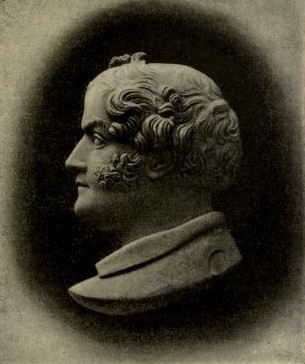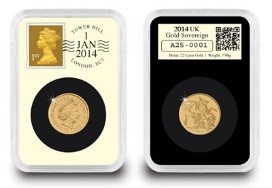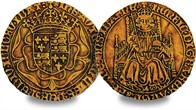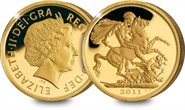Posts Tagged ‘Sovereigns’
The Making of a British Icon
How an Italian engraver produced the most British coin of all time
Across the world, one coin is seen to epitomise all that it is British in a way that compares with nothing else. That coin is the Gold Sovereign. And at the centre of its international reputation is a quintessentially British design – St. George slaying the dragon.
Yet it is not, as you may first think, the work of a classical British artist, but instead that of the second son of an Italian federal court judge, who only came to England just two years before his portrayal of St. George and the Dragon first adorned a British coin in 1817.

Cameo of Benedetto Pistrucci, by his daughter c. 1850
In fact well before his arrival in England in 1815, Pistrucci was already well established as a leading gem engraver and producer of fine cameos amongst European high society. He rapidly made an impression on his arrival in London, winning the approval of the well-known antiquarian William Richard Hamilton.
Despite having no coin or medal experience, he was quickly commissioned by the Master of the Mint Wellesley Pole, brother of the Duke of Wellington, to produce a new portrait of George III as part of the Great Recoinage. His model, created in the unusual medium of red jasper, was re-engraved by Thomas Wyon for its final use on coinage losing, in Pistrucci’s eyes at least, much of the detail.
However, his work was clearly of sufficient quality to impress Pole, who followed up with a commission for the design that has forever since been the synonymous with the name Benedetto Pistrucci – St. George and the Dragon.
A design nearly lost the annals of history
Yet within just eight years it looked like Pistrucci’s design might disappear forever, as the Royal Mint changed the Sovereign reverse design to an heraldic shield, which was to remain in place for the next 46 years.
It was only a drive to improve the design quality of the coinage, led by new Deputy Master, Charles Fremantle that saw the re-introduction of St. George in 1871. However, both reverse designs were struck concurrently until 1887 when the Chancellor of the Exchequer declared that “by tradition and recommended by the great beauty of the design” Pistrucci’s design should once again appear on all Gold Sovereigns.
“The chief coin of the world”
By the mid-1850s the “new” Gold Sovereign had become a coin of true international status. Indeed an official list identifies no fewer than thirty-six colonies and dependencies in which the gold sovereign or half sovereign was recognised as legal tender.
More surprisingly, so great had become the reputation of the British sovereign that it was also in regular use in other countries outside the Empire, including Brazil, Egypt and Portugal.
However, it was the opening of the Sydney branch of the Royal Mint in 1855 following the discovery of gold in Australia that really marked the international growth of the Sovereign. Initially authorised to strike Sovereign’s to a different design, in 1871 Sydney finally started to strike coins of the same designs as the UK (just in time for the Pistrucci revival), only identified by a small “S” mintmark.
Further Australian Royal Mint branches followed in Melbourne in 1871 and Perth in 1899, before the Mint’s reach extended to other Empire countries with branches opening in Ottowa (1899), Bombay (1918) and Pretoria (1923) – all producing Gold Sovereigns.
It is no wonder that the eminent economist of the early 20th Century, Sir John Clapham, proclaimed the Gold sovereign as “the chief coin of the world”.
A worldwide modern icon – good enough for 007
The last international sovereign was struck in Pretoria in 1932. By then the international interest in Gold Sovereign, which started in Victorian times was well and truly established. And it is a reputation that continues right up to today.
Ian Fleming chose to equip James Bond with 50 Gold Sovereigns in his attaché case in the From Russia with Love, whilst Special Forces are still believed to carry Gold Sovereigns, as an emergency international currency.
In 2012 the Royal Mint once again authorised the striking of the St. George and the Dragon Gold Sovereign outside the UK under licence in India, so great is its popularity amongst the people there.
Reference
“The Royal Sovereign 1489 – 1989”, Ed GP Dyer
“A New History of the Royal Mint”, Christopher Edgar Challis
The Royal Mint Museum Website
________________________________________________________________

The 2014 Gold Sovereign is available in a limited edition DateStamp™ Presentation of just 995 pieces –now sold out.
Pistrucci’s iconic Sovereign design back for 2013
After months of speculation, 2013 well and truly got off with a bang following today’s unveiling of one of the year’s most exciting and eagerly awaited new issues – the UK Gold Proof Sovereign.

Pistrucci’s nearly 200 year-old design graces the reverse of the 2013 Gold Proof Sovereign once more
Nearly 200 years young
And after the change of reverse design on last year’s Diamond Jubilee Sovereign (only the fourth ever in the coin’s long and illustrious history), Benedetto Pistrucci’s almost 200 year-old Sovereign design makes a welcome return in 2013.
The one and only Sovereign design
For many collectors, Pistrucci’s classical depiction of Saint George slaying the dragon remains the definitive Sovereign design; it has in fact appeared on the coinage of every British monarch since George III. Fittingly, it is also 60 years since the pair first appeared on the first Sovereigns of the Queen Elizabeth II’s reign in 1953.
Another record Sovereign sell-out expected
Struck in 22 Carat Gold to the highest proof finish by the master craftsmen of The Royal Mint, the Sovereign has long been considered Britain’s most famous and sought-after coin.
Last year’s Gold Proof Sovereign sold out in record time and it’s widely anticipated that the 2013 coin will follow suit. There are however just 7,500 available worldwide so orders should be placed immediately.
Click here for a full range of sovereign coins currently available from The Westminster Collection
Read up on the History of the Sovereign
History of the Sovereign
The gold Sovereign is one of the most famous coins in the world. “Sovereign” is the name we give to a gold coin, originally of one pound sterling value. The first pound was struck in 1489 during the reign of Henry VII. It was a magnificent coin showing on the obverse the king sitting a throne, hence the name “Sovereign.”
The first Sovereigns
Henry VII ordered the Sovereign to be struck as part of the process to stabilise the English economy after decades of civil war. The King commissioned the great German engraver Alexander of Bruchsal to design the coin, showing Henry VII enthroned on the obverse and a Tudor rose enclosing a shield on the reverse. Its value was 240 silver pennies or twenty shillings. This was the first Sovereign – it was struck in 23 carat (95.83% fine) gold.
Debasement and replacement
King Henry VIII increased the sovereign’s value from 20 shillings to 22 shillings then 22 shillings and 6d. His son, Edward VI fixed the value at 20 shillings and also issued a half sovereign, a “Fine Sovereign” of 30 shillings and a double sovereign. After his death in 1553, his half sister, Queen Mary issued only a “Fine Sovereign” of 23¾ carats. Mary died in 1558 and her successor, Elizabeth I re-introduced a “standard sovereign” of 22 carats, worth 20 shillings, circulating alongside the fine sovereign. James I eliminated the fine sovereign and introduced a smaller, lighter sovereign of 22 carat fineness in 1604. This was to be the last sovereign struck in England for 213 years.
Unite, Laurel, Broad and Guinea
After the Sovereign there followed a succession of coins, of roughly sovereign value. First came the “Unite” of one pound value. It was so called in honour of the uniting of the kingdoms of England and Scotland. In 1612 the Unite was revalued at 22s before being replaced in 1619 by the “Laurel.” It survived the Civil War and was circulated during the Commonwealth, although a smaller 20 shillings coin, “the Broad”, was briefly issued in 1656. The Unite was issued for two years by the restored Charles II but was replaced by the machine-made “Guinea” (so called because it used gold from Guinea, West Africa) in 1668.
The Sovereign reigns supreme
In 1809 The Royal Mint was moved from the Tower of London to a new site on Tower Hill. In 1813 the last Guinea, with a value of 21 shillings, was struck by The Royal Mint but a huge transformation in how British coins were produced was about to take place. Using the new steam-powered minting machines of Boulton and Watt, the Mint could now produce superior coins more quickly and on an industrial scale. The Mint also now issued coins with a face value greater than their intrinsic value – the world’s first “token” coinage – and in 1817 came the return of the gold Sovereign after 213 years. On its reverse was the iconic engraving of St George and the Dragon by the brilliant Italian engraver Bendetto Pistrucci. This is essentially the modern gold Sovereign we know today, minted to 22 carat (91.7%) fineness, 22.05 mm in diameter and weighing 7.988 g.
The George & Dragon design continued to be used exclusively on the reverse of Sovereigns until 1825, when a shield design was introduced. The shield continued to be used intermittently throughout the reigns of George IV, William IV and Queen Victoria. As the British Empire spread across the globe, the sovereign went with it, accepted and trusted in even the most remote parts of the world. In 1855 the Sydney Branch of The Royal Mint was established. Uniquely, its Sovereigns (identified by the mintmark “S”) were completely different in design to the British originals. Other Royal Mints striking Sovereigns were opened at Melbourne, Perth and Ottawa, Canada.
A new life for the Sovereign
In 1917, under pressure of the war effort, The Royal Mint stopped production of the gold sovereign, replacing it with paper currency for everyday circulation. Although the Mint produced some Sovereigns in 1927 and proof sets in 1937 and 1953, this effectively marked the end of the Sovereign as currency. However, in 1957, in response to demand from collectors and investors, The Royal Mint issued bullion sovereigns almost every year until 1968, resuming regular production in 1974. In 1979 the Mint issued proof versions, which were so popular the practice continues to this day.
In 1989 the 500th anniversary of the sovereign was marked by a special commemorative proof issue, while the Queen’s 2002 Golden Jubilee saw the shield design used, in modified form, on the reverse of a Sovereign for the first time since 1887. Most recently, the 2012 Sovereign featured a new reverse design by Paul Day to mark the Queen’s Diamond Jubilee. Over the past decade bullion and proof Sovereigns have proved a sound investment. As long as there’s a pound, it seems likely we’ll still have a Sovereign.





